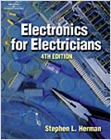Description: Now in its fourth edition, Electronics for Electricians is written for apprentices and readers preparing for work in industrial settings. Components and circuits are explained in a clear-cut manner throughout the book, with emphasis on describing how they work, what they do, how to use them in a working circuit, and how to test them. With successfully proven laboratory experiments in every chapter, this book exposes readers to the electronic devices commonly found in industry as well as the circuit applications of those devices. In the process, it offers its readers a more practical and relevant path to understanding how electronics theory is applied in the electrical field. Product Benefits: - New information on semi-conductor materials, metal oxide varistors, variable frequency drives, and LEDs is included in this edition.
- A non-mathematical approach is used to ensure that electrical apprentices and readers easily understand the concepts at work, regardless of their academic backgrounds.
- Experiments in the book use common, over-the-counter components that are relatively inexpensive and easy to obtain.
- Chapter-end review questions allow readers to gauge their understanding before proceeding to the next topic.
- Ohm's Law formulas, parts lists, schematic symbols, plus conversion factors for sine-wave voltages are contained in handy appendices.
Table of Contents: Preface.
Unit1. The Oscilloscope.
Unit2. Semiconductors.
Unit3. Power Rating and Heat Sinking Components.
Unit4. Junction Diodes.
Unit5. Light-Emitting-Diodes (LEDs) and Photodiodes.
Unit6. Single-Phase Rectifiers.
Unit7. The Polyphase Rectifier.
Unit8. Filters.
Unit9. Special Diodes.
Unit10. The Transistor.
Unit11. The Transistor Switch.
Unit12. The Transistor Amplifier.
Unit13. The Darlington Amplifier.
Unit14. Field Effect Transistors.
Unit15. Current Generators.
Unit16. The Unijunction Transistor.
Unit17. The SCR in a DC Circuit.
Unit18. The SCR in an AC Current.
Unit19. Phase Shifting an SCR.
Unit20. UJT Phase Shifting for an SCR.
Unit21. SCR Control of a Full-Wave Rectifier.
Unit22. A Solid-State Alarm with Battery Backup.
Unit23. The Diac and Silicon Bilateral Switch.
Unit24. The Triac.
Unit25. Phase Shifting the Triac.
Unit26. Other Methods of AC Voltage Control.
Unit27. The Solid-State Relay.
Unit28. The Oscillator.
Unit29. The DC to DC Voltage Double.
Unit30. The Off-Delay Timer.
Unit31. The On-Delay Timer.
Unit32. The Pulse Timer.
Unit33. The 555 Timer.
Unit34. The 555 Timer Used as an Oscillator.
Unit35. The 555 On-Delay Timer.
Unit36. The 555 Pulse Timer.
Unit37. Above and Below-Ground Power Supplies.
Unit38. The Operational Amplifier.
Unit39. The 741 Op Amp Level Detector.
Unit40. The 741 Operational Amplifier Used as an Oscillator.
Unit41. Voltage Regulators.
Unit42. Digital Logic.
Unit 43. The Bounceless Switches. Circuit Applications.
Unit44.Design of Circuit #1 (Photodetector).
Unit45. Design of Circuit #2 (Animal Feeder).
Unit46. Design of Circuit #3 (Solid-State Pushbutton Control).
Unit47. Design of Circuit #4 (Electronic Locks).
Unit48. Design of Circuit #5 (Solid-State Thermostat). Appendix A. Testing Solid-State Components. Procedure 1. Testing a Diode. Procedure 2. Testing a Transistor. Procedure 3. Testing a Unijunction Transistor. Procedure 4. Testing a SCR. Procedure 5. Testing a Triac. Appendix B. Ohm''s Law Formulas. Appendix C. Parts List. Appendix D. Schematic Symbols. Appendix E. Conversation Factors for Sine-Wave Voltages. Glossary. Index. |

